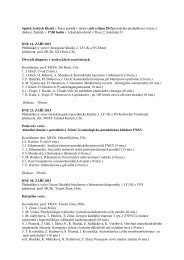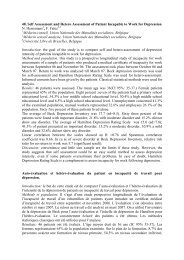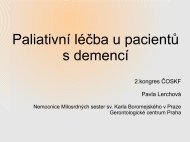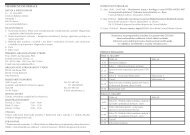ABSTRACTS â ORAL PRESENTATIONS - AMCA, spol. s r.o.
ABSTRACTS â ORAL PRESENTATIONS - AMCA, spol. s r.o.
ABSTRACTS â ORAL PRESENTATIONS - AMCA, spol. s r.o.
You also want an ePaper? Increase the reach of your titles
YUMPU automatically turns print PDFs into web optimized ePapers that Google loves.
aberrant expression, localization and phosphorylation of connexin43 in vitro. They are<br />
also characterized by a loss of contact inhibition of growth and capability of anchorageindependent<br />
growth.<br />
Chemopreventive and anticancer effects of phytochemicals tested were evaluated on<br />
three different levels (endpoints). Restoration of oncogene-inhibited gap junctional<br />
intercellular communication (GJIC), which represents a key cellular event linked to<br />
tumor promotion and chemoprevention, was investigated in WB-ras cell line using<br />
scrape loading/dye transfer assay. Selective antiproliferative and/or cytotoxic effects of<br />
phytochemicals towards tumorigenic WB-ras cells were assessed by neutral red uptake<br />
assay and compared with phytochemical effects in normal non-tumorigenic WB-F344<br />
cell line. In addition to that, alterations of cell cycle induced by phytochemial treatment<br />
were also studied in both cell lines using propidium iodide staining and flow cytometry<br />
measurement.<br />
The results of conducted experiments suggested that tested phytochemicals were able<br />
to selectively affect evaluated parameters in tumorigenic WB-ras cells, indicating their<br />
chemopreventive and anticancer activity as well as possible alterations of ras-dependent<br />
signaling. The employed in vitro models/methods were thus demonstrated to be a<br />
valuable and effective tool for future phytochemical and dietary compound screening<br />
for cancer chemopreventive and anticancer activity and for further characterization of<br />
their mechanisms of action.<br />
Acknowledgements<br />
This work was supported by a research grant of the Ministry of Education, Youth and Sports<br />
LH12034 (CHEMOPREV) - Novel in vitro approach for identification of chemopreventive<br />
effects and mechanisms of phytochemicals (LH KONTAKT II funding programme).<br />
P20. IMMUNOMODULATORY PROPERTIES OF CANDIDA GLABRATA CELL WALL<br />
MANNAN<br />
Lucia Paulovičová 1 , Ema Paulovičová 1 , Eva Pericolini 2 , Elena Gabrielli 2 , Anna Vecchiarelli 2<br />
1<br />
Center of Excellence Glycomed, Department of Immunochemistry of Glycoconjugates,<br />
Institute of Chemistry, Slovak Academy of Sciences, Bratislava, Slovak Republic;<br />
chemluli@savba.sk<br />
2<br />
Microbiology Section, Department of Experimental Medicine and Biochemical Sciences,<br />
University of Perugia, Perugia, Italy<br />
The yeasts Candida glabrata is a human commensal fungus that resides on the skin,<br />
mucosa surfaces and gastrointestinal tract of healthy individuals. Although C. glabrata is<br />
not pathogenic under normal host conditions, it can cause infections when host defence<br />
is compromised. In Slovakia C. glabrata was the second abundant human pathogen<br />
according to the frequencies in clinical isolates from upper (16.3%), low respiratory<br />
tract (24.5%) and gynaecological swabs (6%) following C. albicans (Mycology Labs.,<br />
HPL ,Slovakia). This fungus is associated with a wide spectrum of diseases in humans,<br />
ranging from acute superficial infections of skin and mucosal membranes due to impaired<br />
110 Analytical Cytometry VII








